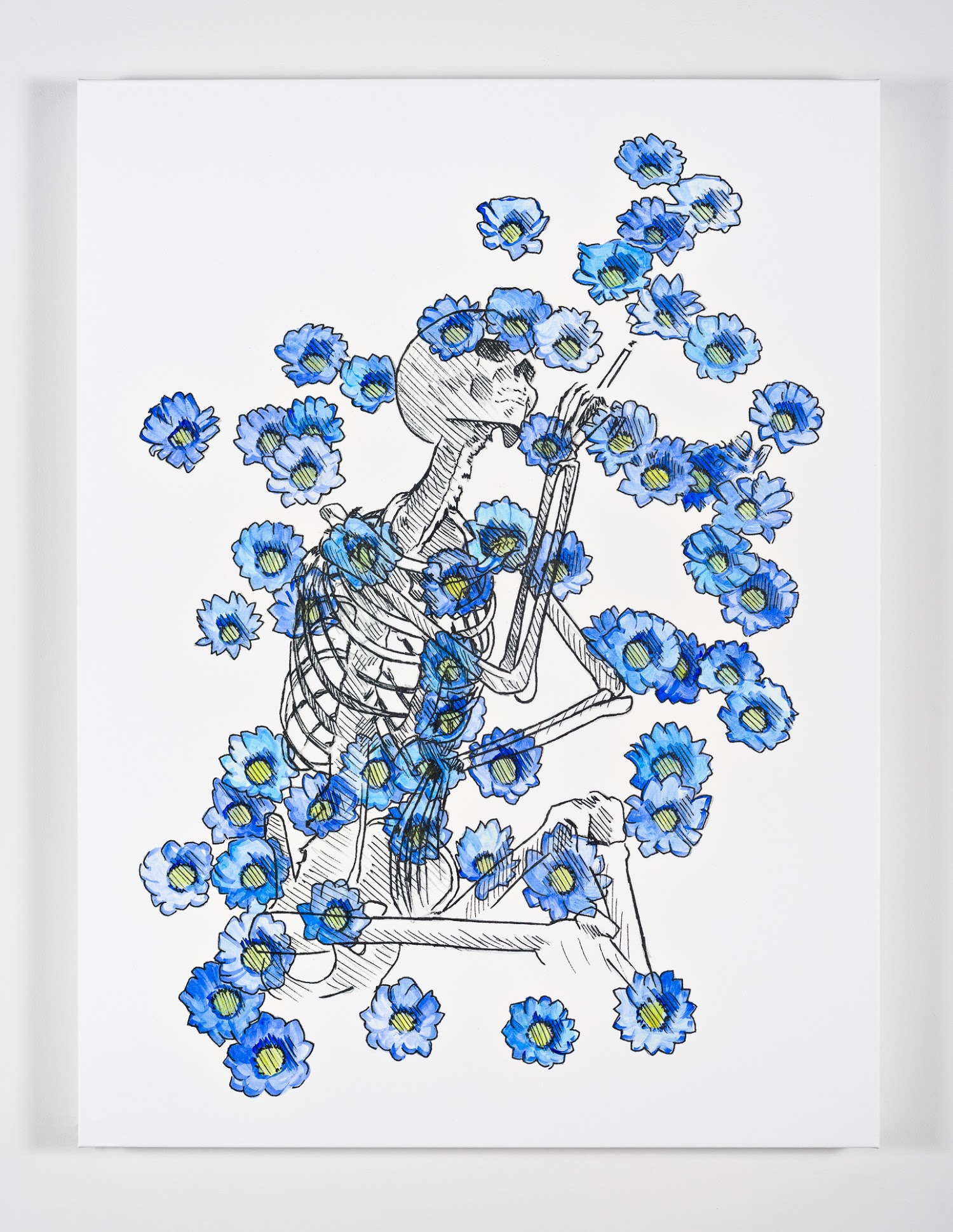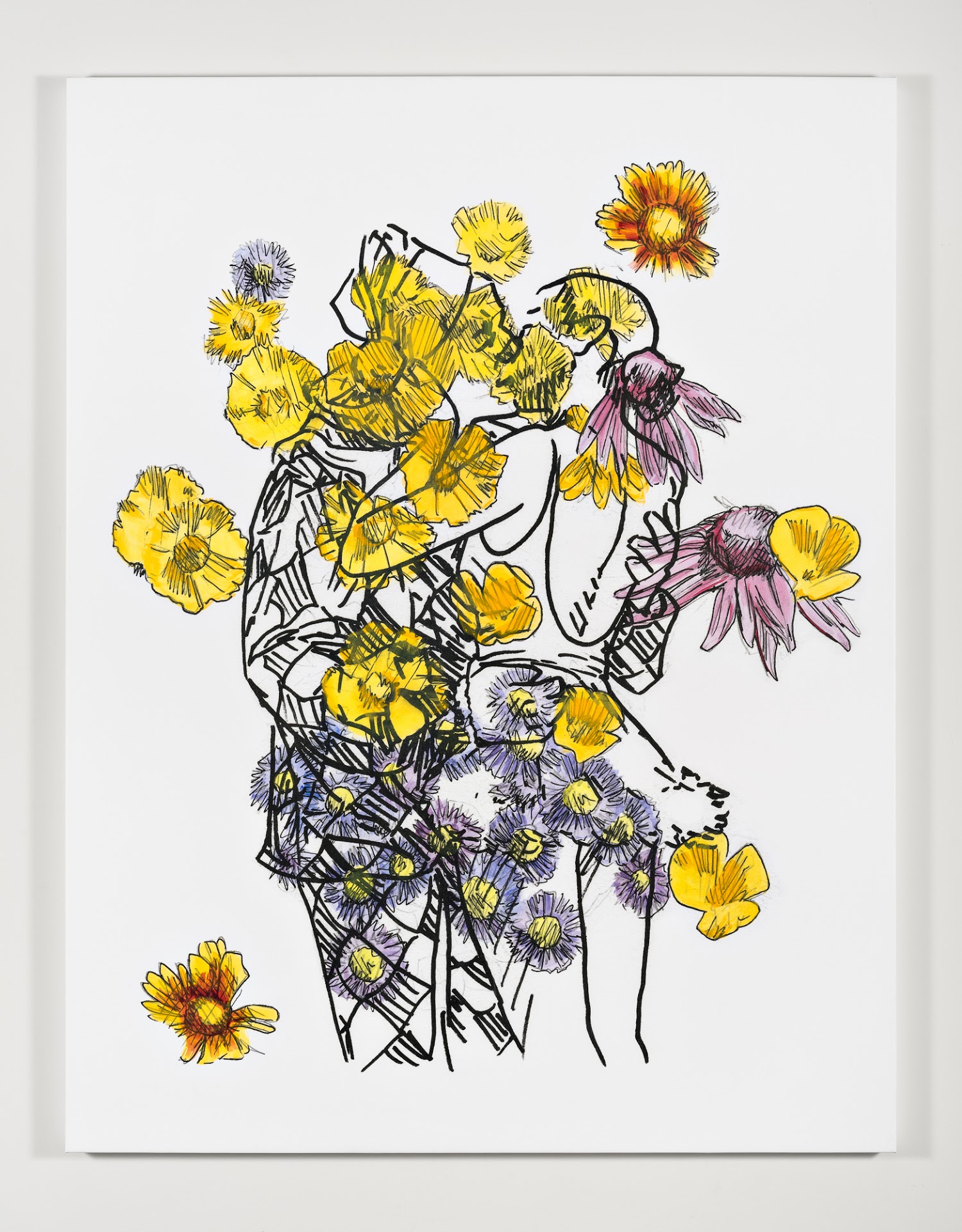Mieke Marple
God is an Audiobook
1301PE Annex on Wilshire
6150 Wilshire Boulevard, Los Angeles, CA 90048
April 10 – May 10, 2019
Now on view at 1301PE, God is an Audiobook is Mieke Marple’s first solo exhibition with the gallery. Marple is an artist and writer and this new series of paintings combines her interests in both visual and textual narrative.
In White Girls Have Depth Too, a mini-memoir presented as a companion piece to the paintings on view, Marple describes becoming familiar with the work of Eckhardt Tolle via audiobooks. Initially skeptical that “self-help” content would appeal to her, Marple developed a deep interest in the material, one that bordered on obsession. Her early skepticism stemmed from many of the same value judgments made in the field of visual arts, in which “high art” is contrasted with “low-brow art,” “folk art,” “graphic art,” et cetera and where highly emotional content in artwork is often seen as naïve or in conflict with intellectual/commercial interests. In her mini-memoir, Marple also attempts to portray whiteness, historically treated as “neutral,” as a distinct and articulable experience. It is also one in which, despite the relatively low-brow status of the self-help genre, understanding self-actualization as an act of privilege is often overlooked.
In this new series of paintings, Marple presents different archetypes—skeletons, clowns, ballerinas, hermits, et cetera—and creates a bright and vivid atmosphere by layering these images with renderings of flowers. These flowers do not function in a symbolic manner in the paintings; instead, Marple suggests, “They are mood. They simply are and in this way resemble consciousness or presence.” In A New Earth, Tolle writes that flowers were likely the first non-functional objects to be appreciated by humans because of their ability to mirror consciousness back to us. Marple considers the flowers, rendered realistically, to be analogous to “situation” in writing, i.e. uninterpreted moments that happen in a specific place and time. By contrast, the central, unpainted archetypes are analogous to “story” in writing, i.e. larger themes that run through the course of a text. To accompany her paintings, Marple also created a short video animation pairing several of her drawings with the sound of Tibetan bells, the same sound Tolle uses in his audiobooks to demarcate chapters.
In these artworks and mini-memoir, Marple attempts to balance the personal with the universal and the specific with the abstract. Marple picks subjects that are open to projection and then fleshes them out through the addition of flowers in her paintings and conversations in her mini-memoir to create an embodied experience by which the reader/viewer can access universal tropes.

Installation view, God is an Audiobook, Mieke Marple at 1301PE, Los Angeles, 2019. Courtesy of the artist and 1301PE.

Mieke Marple
Eternal (Suicide/Pansies), 2019
Acrylic paint and inkjet on canvas
70 x 54 x 2 inches
(177.8 x 137.16 x 5.08 cm)

Mieke Marple
Eternal (Day-dream/Ground Flowers), 2019
Acrylic paint and inkjet on canvas
40 x 30 x 2 inches (101.6 x 76.2 x 5.08 cm)

Installation view, God is an Audiobook, Mieke Marple at 1301PE, Los Angeles, 2019. Courtesy of the artist and 1301PE.

Installation view, God is an Audiobook, Mieke Marple at 1301PE, Los Angeles, 2019. Courtesy of the artist and 1301PE.

Mieke Marple
Eternal (Kiss/Wildflowers), 2019
Acrylic paint and inkjet on canvas
70 x 54 x 2 inches
(177.8 x 137.16 x 5.08 cm)

Mieke Marple
Eternal (Joy/Morning Glories), 2019
Acrylic paint and inkjet on canvas
70 x 54 x 2 inches
(177.8 x 137.16 x 5.08 cm)

Mieke Marple
Eternal (Pathos/Tulips), 2019
Acrylic paint and inkjet on canvas
40 x 30 x 2 inches (101.6 x 76.2 x 5.08 cm)

Mieke Marple
Eternal (Melancholia/Roses), 2019
Acrylic paint and inkjet on canvas
40 x 30 x 2 inches (101.6 x 76.2 x 5.08 cm)



